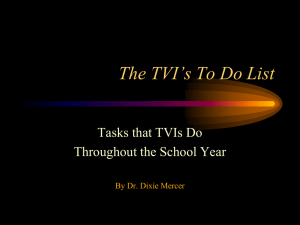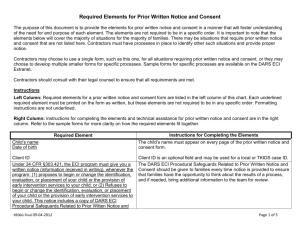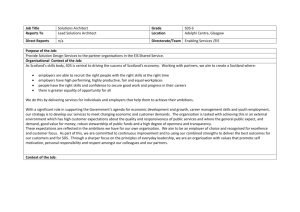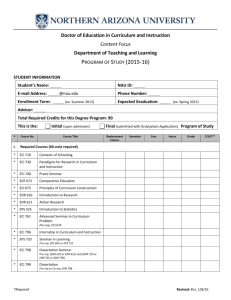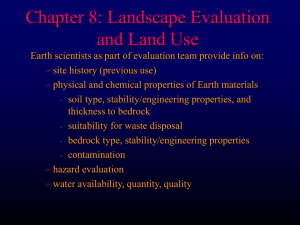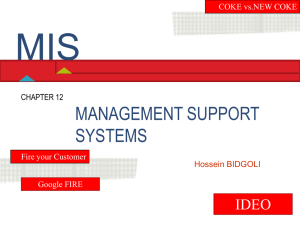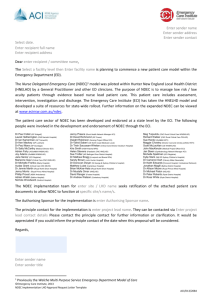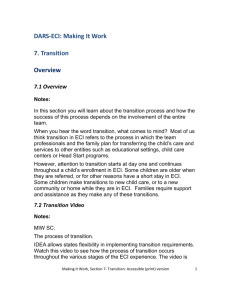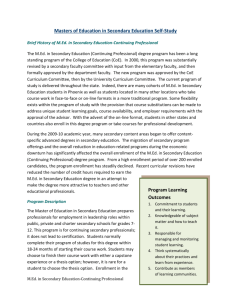SST and Therapies Examples
advertisement
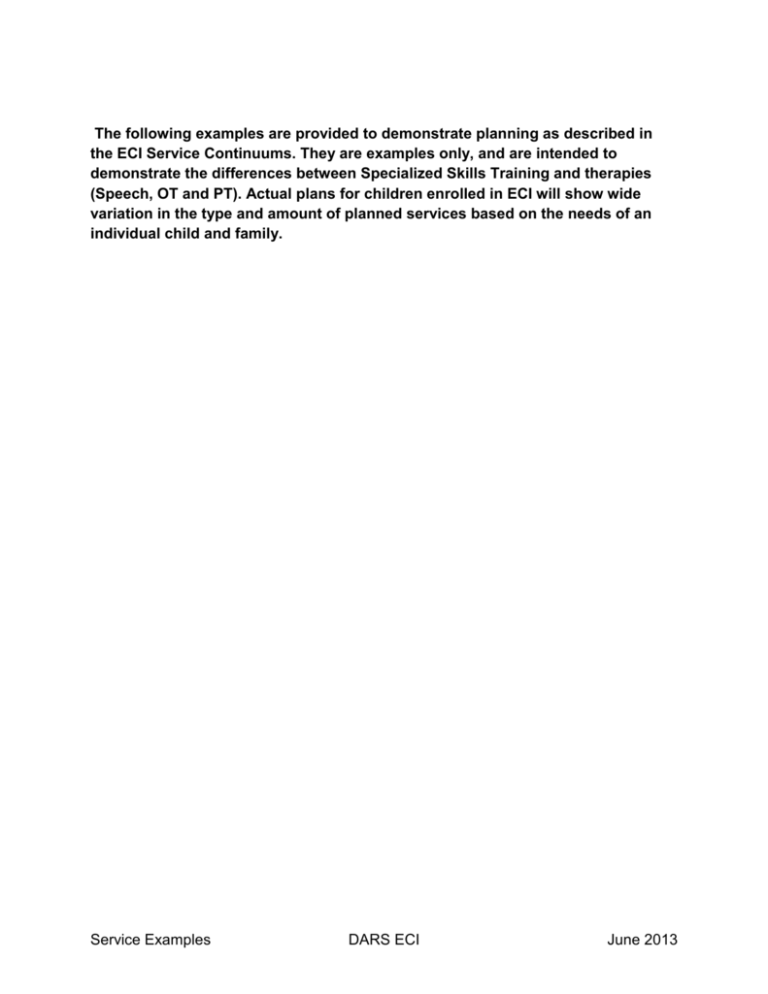
The following examples are provided to demonstrate planning as described in the ECI Service Continuums. They are examples only, and are intended to demonstrate the differences between Specialized Skills Training and therapies (Speech, OT and PT). Actual plans for children enrolled in ECI will show wide variation in the type and amount of planned services based on the needs of an individual child and family. Service Examples DARS ECI June 2013 Specialized Skills Training and Therapies Examples *Child #1 – Down Syndrome. 16 months old. Needs support to sit, but doesn’t like to sit independently and wants to be held. Is just starting to try to use a spoon, but gags and chokes on foods that have consistency greater than strained. Not using any words or gestures to communicate. Outcomes (goals) the professionals recommend and the parent wants to work on (not exact wording from IFSP): 1. When given a spoon and thick food like applesauce she will be able to feed herself most of the meal without help, and without gagging or choking. 2. To sit up by herself and enjoy sitting alone, especially in her highchair and in the cart at the grocery store 3. To enjoy playing with her toys in a variety of ways by putting the balls in the ball drop, scribbling with crayons, and stacking her rings. 4. To say her first word, and use some gestures to tell what she wants. Services this child is receiving: 1. Speech Pathology Services, 2X a month. SLP is teaching the parent oral motor exercises and stimulation activities to improve control of the oral musculature for speech and to decrease the gagging response, and monitoring the progress of the child in this area. She is also teaching the parent some simple sign language to stimulate communication. 2. Physical Therapy 2 X a month. PT is teaching the parent strengthening exercises for trunk strength for sitting, strengthening shoulders, arm and hand use for play, and monitoring the progress of the child’s motor development. 3. Specialized Skills Training, 4X a month. The EIS is working with the parents to provide strategies on how to extend the amount of time that child will sit, both at feeding and for play, in order to strengthen her core muscles and extend her attention span for play. The family’s life is chaotic, and the parent needs frequent support in order to adapt strategies from week to week. The EIS is emphasizing learning through play activities, and is helping the parent learn to handle some behavior issues that interfere with sitting independently and self feeding. ______________________________________________________________________ * Example only. Intended to demonstrate the differences between Specialized Skills Training and therapies (Speech, OT and PT). Actual plans for children enrolled in ECI will show wide variation in the type and amount of planned services. Service Examples DARS ECI June 2013 *Child #2 – 19 months old. Mild to moderate delays in motor and communication but progressing slowly according to developmental norms. No neuromuscular or musculoskeletal challenges, no oral motor concerns. Outcomes (goals) the professionals recommend and the parent wants to work on (not exact wording from IFSP): 1. To move around the house by walking independently 2. To say “mama”, “daddy”, and at least 5 other words to tell what he wants. 3. To play in the centers at his daycare such as the transportation center, housekeeping center etc. Services this child is receiving: 1. Specialized Skills Training 4X a month; 2 X at the daycare, 2X at home. The EIS is assisting his teachers at the daycare to find ways to arrange the environment to make it easier for him to build strength and attempt to walk. She is working with the child during center time to help him discover ways to play with the materials in order to increase his cognitive and language development. The EIS will assist his parents on stimulating his language at home during their regular routines, and will help them arrange the environment at home to encourage walking and communication. 2. Physical Therapy – 1X 2 months consultation. The PT recommends periodic assessment of his progress in walking and in play and will provide additional strategies as needed to the EIS and the parent. ______________________________________________________________________ * Example only. Intended to demonstrate the differences between Specialized Skills Training and therapies (Speech, OT and PT). Actual plans for children enrolled in ECI will show wide variation in the type and amount of planned services. Service Examples DARS ECI June 2013 Child #3 – 30 months of age. Severe delays in speech and language development with suspected childhood apraxia of speech. Child has been removed from one daycare center due to behavior issues which are related to his frustration around communication. Parent is concerned that they will be asked to leave their current, part time child care program. Outcomes (goals) the professional recommend and the parent wants to work on (not exact wording from IFSP): 1. To say “mama”, “daddy” and 4 other words to communicate what he wants 2. To go to child care for one month without reports of tantrums, aggression, or other behavior concerns by the staff. Services this child is receiving: 1. Speech Pathology Services 2X a week, at home. SLP teaches, demonstrates and coaches parent in very specific, targeted exercises and activities to improve the child’s motor speech control. 2. Specialized Skills Training 4X week, at the child care program. EIS is working with the child and the child care teachers on encouraging non-verbal and vocal communication in order to decrease negative behaviors, and develop other social skills that will allow the child to be more successful in the child care setting. The EIS will identify adaptions to the classroom that can help the child be successful, assessing possible implementation of picture communication or choice charts. The EIS will stay in contact with the SLP and as the child progresses in speech production, the EIS will assist with activities that encourage the child to use his newly acquired skills in the class. ______________________________________________________________________ * Example only. Intended to demonstrate the differences between Specialized Skills Training and therapies (Speech, OT and PT). Actual plans for children enrolled in ECI will show wide variation in the type and amount of planned services. Service Examples DARS ECI June 2013 Child #4 – 7 months old. Child is premature with an adjusted age of 5 months. Most of his delays can be attributed to prematurity and he qualified for ECI based on motor concerns that are related to muscle tone, movement patterns and irritability. He wakes up multiple times during the night. Family has many questions and concerns about how to help the baby develop. Outcomes (goals) the professionals recommend and the parent wants to work on (not exact wording from IFSP): 1. To play with his toys while on his tummy without fussing while Mom is fixing dinner 2. To sit up in his high chair and in his bumbo chair without additional support 3. To sleep six hours at night (uninterrupted) and take at least one nap during the day Services this child is receiving: 1. Physical Therapy – 4 x a month. PT is teaching the family strategies to improve muscle tone and movement patterns. PT is teaching the parent strengthening exercises for trunk strength for sitting, strengthening shoulders, arm and hand use for play, and monitoring the progress of the child’s motor development. 2. SST 4 x a month EIS is providing strategies to calm the baby and teaching the family how to maximize play opportunities for maximum development into their daily routines. EIS is providing support to the family and addressing their questions and concerns about overall development and providing strategies for helping the child sleep. ______________________________________________________________________ * Example only. Intended to demonstrate the differences between Specialized Skills Training and therapies (Speech, OT and PT). Actual plans for children enrolled in ECI will show wide variation in the type and amount of planned services. Service Examples DARS ECI June 2013


